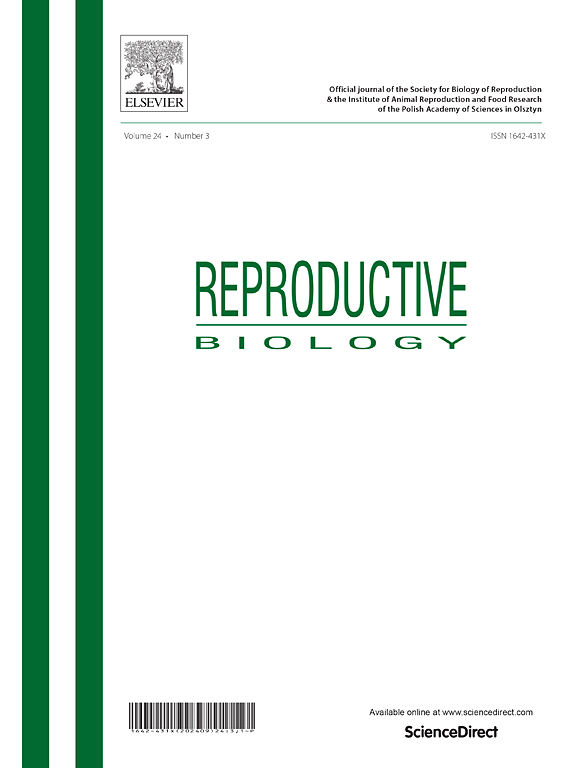Ganoderma lucidum mitigates oxidative stress and apoptosis in chlorpyrifos‑induced testicular toxicity in male rats
IF 2.5
3区 生物学
Q3 REPRODUCTIVE BIOLOGY
引用次数: 0
Abstract
Chlorpyrifos (CPS) is an organophosphate pesticide known to induce oxidative stress, apoptosis, and histopathological damage in male reproductive tissues. Ganoderma lucidum (GDL), a medicinal fungus rich in bioactive polysaccharides and triterpenoids, has demonstrated potent antioxidant and antiapoptotic properties in various models. This study aimed to evaluate the protective effects of GDL extract against CPS-induced testicular toxicity in male rats by assessing histological integrity, oxidative stress markers, apoptosis signaling, and hormonal balance. Twenty-four adult male Wistar rats were randomly divided into four groups (n = 6): Cont, CPS (20 mg/kg), GDL (150 mg/kg), and Treat. Treatments were administered orally once daily for 30 days. At the end of the study, the testes were harvested for morphometric and Cosentino histopathological scoring, immunohistochemistry for BAX, BCL2, and Ki67, RTqPCR quantification, biochemical assays of antioxidant enzymes and serum testosterone, LH, and FSH measurements. CPS treatment significantly elevated histopathological damage scores, and disrupted regular cell arrangement. IHC revealed increased BAX and decreased BCL2 and Ki67 expression, corroborated by the upregulation of Bax and Caspase3 transcripts and downregulation of Bcl2. Antioxidant enzymes were suppressed and MDA was elevated in the CPS group. Hormonal assays showed decreased testosterone and LH. Co-administration of GDL partially restored histological architecture, normalized Voronoi patterns, attenuated apoptotic marker alterations, enhanced antioxidant defenses, reduced lipid peroxidation, and recovered hormone levels toward control values. GDL extract confers significant protection against CPS-induced testicular injury by mitigating oxidative stress, modulating apoptotic pathways, and preserving endocrine function, highlighting its therapeutic potential against pesticide-related reproductive toxicity.
灵芝可减轻毒死蜱诱导的雄性大鼠睾丸毒性中的氧化应激和细胞凋亡
毒死蜱(Chlorpyrifos, CPS)是一种有机磷农药,已知会引起雄性生殖组织的氧化应激、细胞凋亡和组织病理学损伤。灵芝(Ganoderma lucidum, GDL)是一种富含生物活性多糖和三萜的药用真菌,在多种模型中显示出有效的抗氧化和抗凋亡特性。本研究旨在通过评估组织完整性、氧化应激标志物、凋亡信号和激素平衡来评估GDL提取物对cps诱导的雄性大鼠睾丸毒性的保护作用。24只成年雄性Wistar大鼠随机分为4组(n = 6):对照组、CPS(20 mg/kg)组、GDL(150 mg/kg)组和治疗组。治疗方法为每日口服1次,连续30天。在研究结束时,收集睾丸进行形态计量学和Cosentino组织病理学评分,BAX、BCL2和Ki67的免疫组织化学检测,RTqPCR定量检测,抗氧化酶生化检测和血清睾酮、LH和FSH测量。CPS治疗显著提高了组织病理学损伤评分,并扰乱了正常的细胞排列。IHC显示BAX表达升高,BCL2和Ki67表达降低,证实了BAX和Caspase3转录上调和BCL2下调。CPS组抗氧化酶抑制,MDA升高。激素检测显示睾酮和黄体生成素下降。共同给药GDL部分恢复了组织结构,正常化了Voronoi模式,减弱了凋亡标记物的改变,增强了抗氧化防御,减少了脂质过氧化,并将激素水平恢复到控制值。GDL提取物通过减轻氧化应激、调节细胞凋亡途径和保持内分泌功能,对cps诱导的睾丸损伤具有显著的保护作用,突出了其治疗农药相关生殖毒性的潜力。
本文章由计算机程序翻译,如有差异,请以英文原文为准。
求助全文
约1分钟内获得全文
求助全文
来源期刊

Reproductive biology
生物-生殖生物学
CiteScore
3.90
自引率
0.00%
发文量
95
审稿时长
29 days
期刊介绍:
An official journal of the Society for Biology of Reproduction and the Institute of Animal Reproduction and Food Research of Polish Academy of Sciences in Olsztyn, Poland.
Reproductive Biology is an international, peer-reviewed journal covering all aspects of reproduction in vertebrates. The journal invites original research papers, short communications, review articles and commentaries dealing with reproductive physiology, endocrinology, immunology, molecular and cellular biology, receptor studies, animal breeding as well as andrology, embryology, infertility, assisted reproduction and contraception. Papers from both basic and clinical research will be considered.
 求助内容:
求助内容: 应助结果提醒方式:
应助结果提醒方式:


